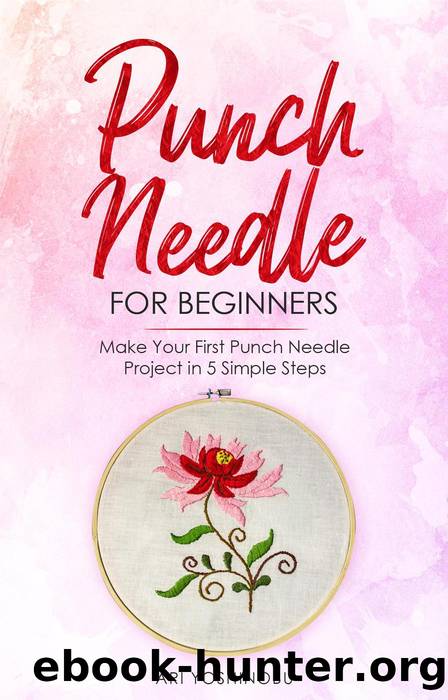Punch Needle for Beginners by Ari Yoshinobu

Author:Ari Yoshinobu
Language: eng
Format: epub
Tags: punch needle book for beginners rug hooking yarn, wool needling punch needle embroidery cloth frame, punch needle patterns magazine rug hooking jit kit, rug hooking recycling tools wool hoop punching, punch embroidery cloth fabric hoops needle pen, punch needle pen oxford craft primitive stitcher, rug hand hooked latch hook kit kids diy
Publisher: CraftMills Publishing LLC
Published: 2020-12-08T00:00:00+00:00
Youâre all done! Project two is complete, and youâve got a comfy pillow all ready for Christmas.
Chapter Seven: Punch a Fuzzy Friend
A fuzzy stuffed animal is a gift that is always treasured, no matter who receives it. That little fuzzy friend will mean all the more if itâs something you put together with your own two hands. Needlepoint embroidery is a particularly great choice for making a stuffed animal, as the loop side is appropriately fuzzy.
Like the other projects in this book, itâs simpler to do than you may think. Itâs going to be very similar to the project you just completed, making a pillow. As you may have guessed, however, weâll add one or two skills, both to keep things interesting and so you can add ideas to your punch needle embroidery bag of tricks. Using the stitches themselves, weâre going to see a fairly simple trick for adding depth and texture to punch needle embroidery art.
To make a stuffed animal, you can sew a canvas or felt backing, as we did with the pillow. Another option is to punch needle embroider a second piece that can serve as a back side. With many stuffed animals, you can just fill in the back with a solid color of stitches. With this project, however, you can basically embroider the same pattern twice and then sew them together, so the stuffed animal has two finished sides. When prepping the second piece of embroidery, keep in mind that you want the looped right side to be on the outside for both halves. That means that the second piece should be mirrored. In other words, if the fish pattern is looking to the right for the first piece of embroidery, it should be facing to the left for the second. This will ensure that the two halves are âfacing the same wayâ and the looped side is facing outward, so your stuffed fish is properly fuzzy.
To get started, youâll need:
â A punch needle (and threading tool)
â Foundation cloth
â Yarn, at least 1 fill color and 1 outline color
â Embroidery hoop
â Pattern - found on the next page
â Washable fabric marker or other marking tool
â Scissors
â Bias band or other strips of thin cloth (optional)
â Glue (optional)
Remember, if youâre going to be making two fishes to make into a complete piece, youâll need twice as much foundation fabric and yarn. Thereâs some detail in the fish that you may also want to outline or highlight with a separate color of yarn. You can fill the fish in with one single color or choose to use a range of colors. There is enough variety in yarn colors that you could choose to do each scale in a different shade if you want to.
Weaverâs cloth might be a good option for a foundation fabric, as it has a tighter weave that will do a better job of holding together. Though, you may want to use monkâs cloth if you want a fuzzier buddy, as that would allow you to select a heavier yarn.
Download
This site does not store any files on its server. We only index and link to content provided by other sites. Please contact the content providers to delete copyright contents if any and email us, we'll remove relevant links or contents immediately.
Kathy Andrews Collection by Kathy Andrews(10509)
The remains of the day by Kazuo Ishiguro(7543)
Spare by Prince Harry The Duke of Sussex(4188)
Paper Towns by Green John(4165)
The Body: A Guide for Occupants by Bill Bryson(3791)
Be in a Treehouse by Pete Nelson(3206)
Harry Potter and the Goblet Of Fire by J.K. Rowling(3025)
Goodbye Paradise(2950)
Never by Ken Follett(2873)
Into Thin Air by Jon Krakauer(2695)
The Remains of the Day by Kazuo Ishiguro(2614)
The Genius of Japanese Carpentry by Azby Brown(2602)
The Cellar by Natasha Preston(2592)
Drawing Shortcuts: Developing Quick Drawing Skills Using Today's Technology by Leggitt Jim(2529)
120 Days of Sodom by Marquis de Sade(2428)
Architecture 101 by Nicole Bridge(2348)
The Man Who Died Twice by Richard Osman(2290)
Machine Learning at Scale with H2O by Gregory Keys | David Whiting(2267)
Fairy Tale by Stephen King(2058)
